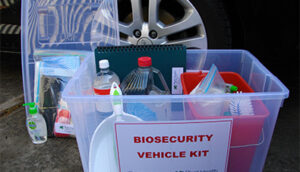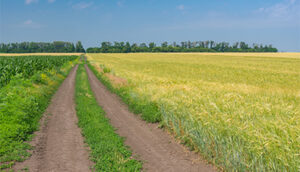Read the latest information on
Foot-and-mouth disease
A vehicle biosecurity kit is a useful tool to help limit the spread of unwanted pests, diseases and weeds on-farm or between farms. A kit should be carried and used by anyone working on-farm such as agronomists, extension officers and farm staff, including itinerant workers and contractors.
Having a vehicle biosecurity kit is the easiest way to ensure that you are prepared and able to clean down and implement hygiene measures.
The contents of a biosecurity kit can vary from farm to farm. They provide provisions for protecting clothing against contamination and keeping footwear and small equipment free of pests and pathogens. The basic contents of all kits should include items for cleaning hands, shoes, small equipment (e.g. soil moisture probes) and vehicle interiors such as:
Permanent marker, vials or small containers, paper bags, or ziplock plastic bags can be included for collecting samples of unusual pests and plant material for further examination and identification. Factsheets on high priority exotic pests for your crops or livestock can be included as a ready reference. Contact details for state agriculture departments for reporting suspect exotic pests and diseases can also be included. Smart phones have access to a camera, have notetaking and GPS capabilities to take photos of suspect symptoms and pests as well as mark the location with the information recorded being easily shared.
Additional suggested items include:
A kit need not be expensive, and all of the items are usually available from a local hardware store. The idea is to keep your hands, clothing and small equipment clean from anything that can cause or spread weeds, pests or diseases.
Vehicle movement should also be minimised between properties to reduce the spread of soil borne diseases and weeds. Try to stay on formed roads and, if possible, have a vehicle that is only used on-farm. If visitors need access to parts of your property, leave their vehicle at the car park and take them where they need to go in the farm vehicle. That way, you will only have to deal with the weeds and potential diseases on your farm, and not those brought in from elsewhere. Visitors can also be sure that they are not taking anything off the farm.
Note: Footbaths are a crucial part of ensuring good farm biosecurity is practiced at on-farm field days, however, if not set up well a footbath can become a biosecurity risk. Footbaths should be set up on a lawn or hard standing surface (e.g. concrete or sealed road). If a footbath must be set up near a field, then provide a substantial hessian bag/mat.
If you don’t know what the pest or disease sign is, or it looks suspicious, call the Exotic Plant Pest Hotline on 1800 084 881.
All calls to the Exotic Plant Pest Hotline will be transferred to the relevant state department where an experienced person will ask questions about what you have seen and may arrange to collect a sample. This person can help connect you with the appropriate expert for identification.
Acknowledgement: Based on an article originally published by the Grains Farm Biosecurity program.